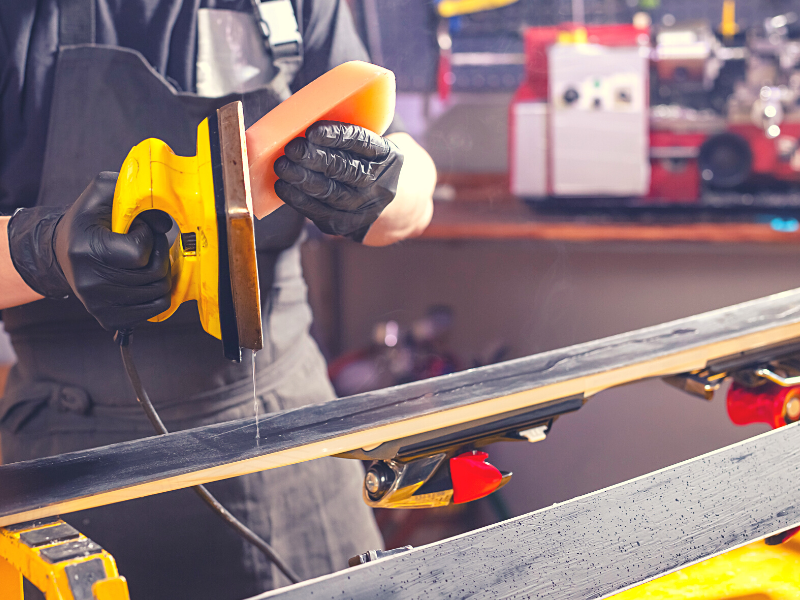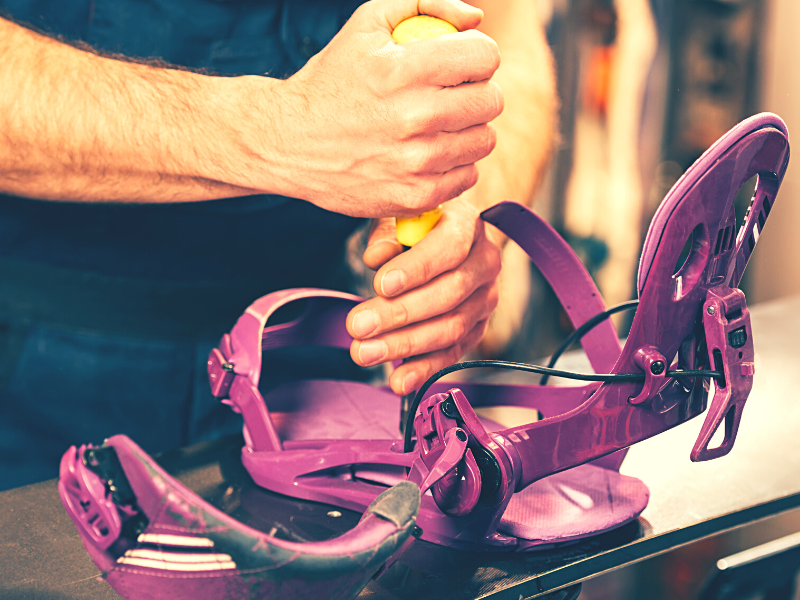Putting on your ski boots is always a struggle, but it’s even worse when you have to do this for the first time. You're most likely new to skiing, and no matter how many videos you watch or people you observe in the wild, this part of the sport just isn't "clicking." So then, how do you put ski boots on?
Here’s how to put ski boots on:
- Open all the buckles
- Move the tongue loop out of the way
- Stand up and insert your foot
- Use the tongue loop to pull the boot up
- Buckle the boots
There's indeed an art to putting ski boots on, but there is no magic. By simply following the process with repetition, it will become easier over time. So, buckle up, let's at the details of putting your ski boots on and some of the tips and pointers that will make it far easier for you.
Is There a Trick to Putting on Ski Boots? Here’s How It’s Done
Experience alone isn’t enough to help make you more adept at putting on ski boots. There isn’t a "trick" per se that makes it possible, although there are some products you can try (more on this to come).
It’s all about knowing how to properly slide your boot in and how your body is positioned, so let’s go over the steps now.
1. Open All the Straps and Buckles
At the very least, you want the top power straps and buckles to be undone when trying to finagle your way into ski boots. The power strap is the thicker band of fabric (or sometimes plastic) that goes over the instep area.
Most boots will have four buckles in total, two over the foot, and two going up the side of your leg (the cuff.) These can be a little tougher to open, especially when they’re new, so wiggle them back and forth if needed.
If you’re still struggling to get your foot in, it's a good idea to open the power strap and all of the buckles completely. This way, your ski boot is as open as it’s going to get.
If you get the hang of it down the line or find the right ratchet setting on the catch, you may not need to open some of the lower buckles all the way, but having the least amount of restriction is going to make putting your foot into the boot a far easier task.
2. Push the Tongue Away From You
With the buckles and straps out of the way, it's time to open the tongue of your boot. Like any pair of shoes, most ski boots will have a tongue that helps keep water and snow out.
When putting your foot in, you want to make sure this is moved out of the way. The easiest way to do this is by simply grabbing it and pushing it away from the inside of the boot (this will depend on the style of boot you have as well.)
Some will need to go to the side to be out of the way, if that's the case, just push it left or right.
The tongue should now be sitting on top of the ski boot's shell or opened as wide as possible. This gives you the most amount of space to work with and makes it much simpler to get your foot in without resistance.
Some will need to go to the side to be out of the way, if that's the case, just push it left or right.
3. Stand and Insert Your Foot
You may put most shoes on when sitting down, but we don’t recommend that with ski boots. It’s too difficult. You could start with your foot halfway in the boot while sitting, but trust us, it's way easier if you stand.
When standing, put one foot into the boot by stepping into it. Start by inserting your toes into the correct spot in the shell, then follow with your heel.
Don’t be afraid to angle your shins and even bend your knee a little bit to insert your foot properly.
Your toes shoes should be close to the edge of the boots, where you can slightly wiggle them, but not too much.
4. Pull the Tongue and Get the Power Strap in Place
Next, you have to get the tongue in the correct default position. Once your foot is all the way in, find the center of the tongue and pull it up.
You want to make sure it’s not bunching on either side, but that the tongue is sitting flat against your shin. This will help with comfort and support while skiing.
From here, you can go ahead and start to close the power strap on each boot. You want it just secure enough that the boot keeps a decent shape, you'll need to tighten it at the end anyways, so don't overdo it at this point.
5. Buckle Up Your Boots and Go
Finally, let's buckle your boots. Start from the bottom and move up. If you're having a hard time getting the buckles to line up, make sure the tongue is in the correct position (step 4) and that your foot is all the way in the boot.
You'll want these buckles nice and tight, but not so much that it's cutting off circulation. And if they're too tight, this can actually ruin the shape of some ski boots. But if you buckle them too loosely, your foot will move around inside the boot and you won't have proper support.
Once all the buckles are in place, you'll want to do a once-over on the power strap, and then you're good to go.
Tips for Easily Putting on Ski Boots
Are you still struggling to get your feet into your ski boots? Here are some pointers that should make it easier to put the boots on.
Use a Boothorn
Shoehorns, which are also known as shoespooners, might not be a tool that the average person has. After all, it’s easy enough to put on sneakers or athletic shoes, but not your ski boots.
A boothorn can change that. To use, insert the horn into the back of your ski boot and hold it firmly against the back from the inside of the boot.
A boothorn has a cup-like shape so that as you slide your foot into the boot, your foot won’t painfully collide with the horn. And it goes the height of your boot's cuff.
Once your foot is in position, you can easily slide the shoehorn out. Keep it handy for next time.
Try a Heated Boot Bag
Warming up the shell of a ski boot will make it more pliable, so this next tip comes highly recommended. You’ll save so much time putting on ski boots moving forward.
Rather than plug in a hair dryer and risk melting the plastic components of your boot with the heating element, try a heated boot bag instead.
Simply insert your boots into the bag and, after some time, the boots will be toasty warm but not burning hot.
The plastic is flexible enough that putting your feet into the boots will be a streamlined process for once.
As a bonus, the warmth within the boots is especially appealing on a cold winter morning.
Hold the Shell Down When Inserting Your Foot
Here’s another tip that ought to make it easier to put on your ski boots.
Don’t just push the tongue when inserting your foot in the boots. Instead, grip the plastic shell on both sides and pull it outward to spread it. This is a lot easier to do if the shell is warm, as it will move with you.
The wider the shell is, the more space you have for your foot.
Why Are My Ski Boots So Hard to Put On?
If you’re still having a hard time with your ski boots, it could be that one of the following obstacles is impeding your progress.
Your Feet Are Wet
When we wear our ski boots with sweaty socks (and let's face it - who doesn't?), they become stickier after a while because of all this sweat collecting on them
Although you think that sliding into ski boots with wet feet would be to your benefit, it’s the opposite.
The liners of the boots can get sticky from the sweat, which prohibits your ease of sliding.
You should wear a different pair of socks first thing in the morning and then change into your ski socks right before you put your boots on. This way, the socks will be dry.
If you're wearing cotton socks, that's a big mistake. Investing in merino wool socks is a far better option - helping with moisture control. If you're unsure what to wear skiing, this article will give you all the tips on what to wear your first time skiing - from head to toe.
Your Boots Are Wet
Ski boots are designed to get wet, and it’s inevitable considering you’re riding through the snow.
Once you’re back in the comfort of your cabin or home, you should dry your boots.
That heated boot bag you bought will come in handy for this. After a short period in the bag, your boots will come out dry and warm.
Alternatively, you could get a boot dryer. The dryer generates airflow inside the shoes where perspiration and moisture accumulate.
Placing your boots near a source of heat such as a radiator or fireplace in the lodge can also help, but this method will take longer. And definitely take caution with how closely you place your boots to the heat... a melted boot could ruin the trip.
Wet boots can augment that sticky feeling and leave you frustrated when you try to put your boots on.
Your Boots Are Cold
You have your work cut out for you if you're trying to put on ice-cold boots. Since a heated boot bag is a multifunctional tool for today’s skier, you should try to get your hands on one.
It will make a huge difference in how easy this part of your ski preparation routine is.
Your Boots May Not Fit
If you’ve tried every tip and pointer we’ve thrown your way and nothing is making a difference in how easily your boots go on, then they might not fit.
The fit of your ski boots should be tight and firm but not so tight that your feet hurt from wearing the boots.
If your feet are too big for your boots, then no matter how much you adjust the straps or how far you pull the tongue, wearing the boots will never become easier.
Try sizing up and see if that helps.
Process, Not Magic, Are Key To Putting On Your Ski Boot
Putting ski boots on can be annoying and uncomfortable if your feet just don’t want to slip into the boots.
Warm up your boots first, keep your feet dry, and adjust the tongue and the plastic shell before sliding your foot in. You should find that the boots go on much more agreeably.



